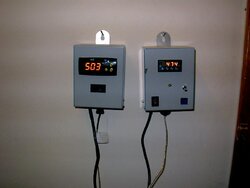I too agree with Ed, but
I've observed that in most stoves (steel), the only criteria often supplied from the manufacturer concerning temperatures is the glowing parts clause. That is the case with my Jotul Kennebec Insert, and I have seen it glow on top (woops). Enameled stoves and Soapstone stoves are obvious exceptions. If I could monitor flue temps, then I can't see how I would get into the problem of an overheated stove, as the flue will give a earlier indication of combustion rate, especially with a probe thermometer. It will respond earlier, and allow you to take action to set a burn using air control rate that won't permit an overheated stove.
I would assert that any overdraft/overfire that would result in a stove overtemp would be seen in the flue gas temp first. I'm thinking that is what a system designeer would measure in a process control situation, especially if clean efficient burning was the goal.
Firefighterjake - Is your description of flue temp a surface temp or flue gas temp - I thought flue gas temp should always be hotter than the stove, unless you just closed a keydamper and shut the air totally, which isn't an option is an EPA setup.
My temp monitoring is still quite active, as I am still finding wet wood and am finding that I can get the stove to cruise at different temps if I adjust the air at different temps, (sort of a max speed cruise @700 vs max range cuise @ 500, from my 4 engine airplane days) and therfore can modulate heat output into the room better.




